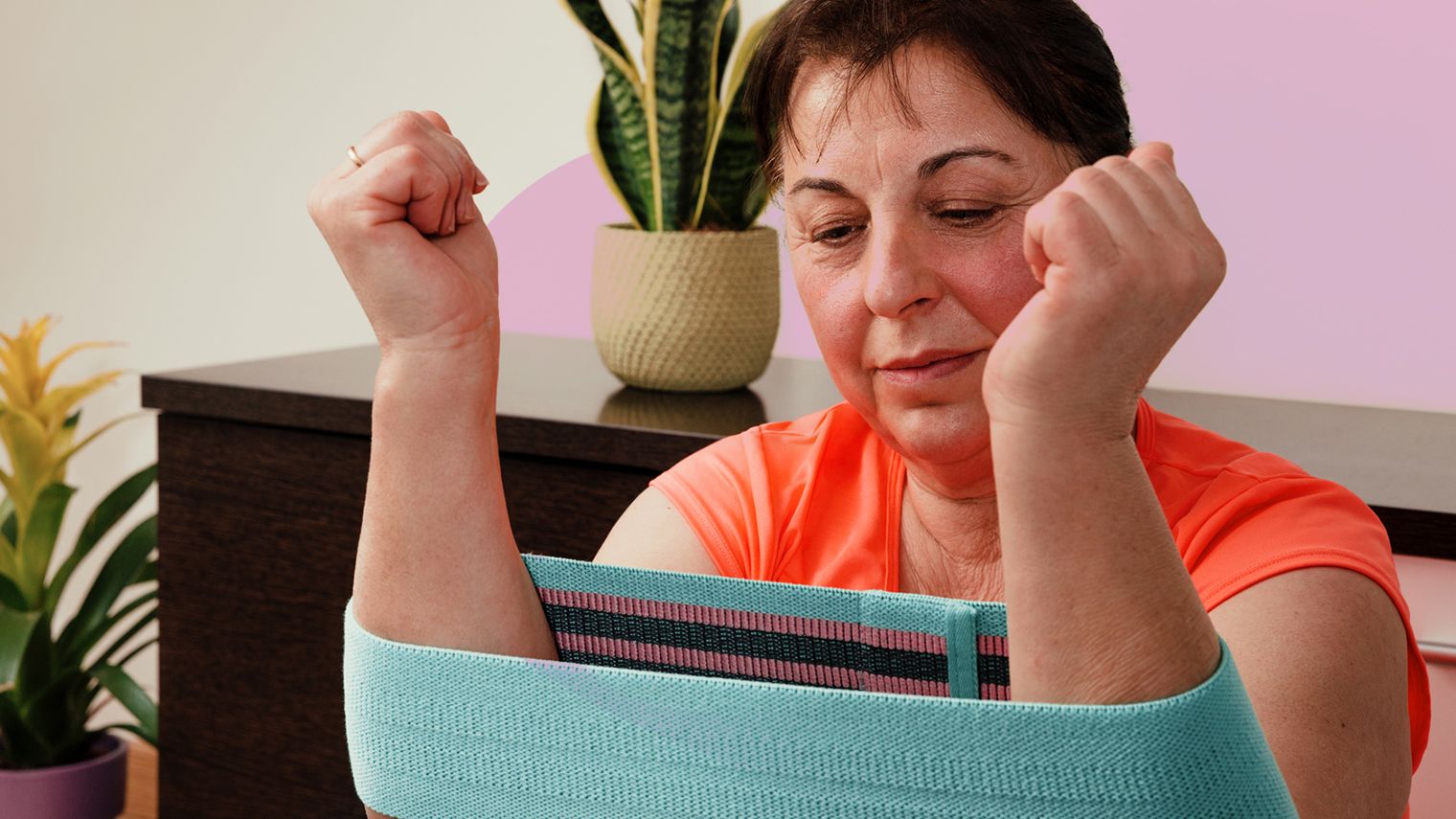How Physical Therapy Exercises Can Help After Breast Cancer Surgery
March 23, 2023
Content created for the Bezzy community and sponsored by our partners. Learn More

Photography by Ángela Rober/Stocksy United
Exercising and stretching your arms, shoulders, and chest after breast cancer surgery can help you maintain mobility and speed up your recovery.
Three days after my bilateral mastectomy, there I was, laid up in an electric-powered recliner with the inability to lift my arms without immense amounts of pain. Drains snaked out of my sides, collecting all the unwanted lymph fluid my body released, their bulbs resting snuggly in tiny pockets I had sewn into my robe just for such an occasion.
I had already gotten the all-clear from my surgeon to start slow exercises at home by that point. He had spent a massive amount of time stressing the importance of stretching and using my arms to do my normal daily tasks if I could.
As I lifted my arms one at a time, tears streaming down my face, I couldn’t help but ask myself, “Is this really necessary?”


Benefits of physical therapy and getting started
The answer to my above internal question was simple — yes, those exercises were necessary, even if they were uncomfortable.
When undergoing surgery for breast cancer (no matter the type), many factors may affect how well or how fast you recover, such as the type of surgery or treatment you had before surgery.
Generally, those who undergo radiation may also find that they have a reduced range of motion in their shoulders and arms compared with those who don’t. Doing exercises regularly to strengthen and maintain mobility is an essential and ongoing step in your recovery.
The most important step is to confirm the proper times to exercise with your doctor and what stretches would work best for you. If you don’t recover your full range of motion within 30 days of surgery, it’s important to speak with your doctor. Depending on your procedure, your doctor may recommend one-on-one physical therapy with a professional.
Tips for stretching and exercising
The trick is to start stretching slowly and with as much restraint as possible. You can start by doing each exercise when lying down. Then, move on to stretching while seated until you can do them while standing.
Within 3 to 7 days of surgery, it’s important to use your affected arm as naturally as possible once you have the go-ahead from your doctor. Doing things like bathing, brushing your hair, or eating with the affected side or both sides will be uncomfortable, but they are important steps to regain your independence. Alternate between your arms when doing these tasks so that you stretch and engage each side evenly.
One simple exercise you can try is to slowly lift your arms at an even level, about shoulder height, until you feel the stretch in your muscles. Then lower them, and repeat this a few times throughout your day.
You may feel strong discomfort, but it shouldn’t be painful. If you’re feeling genuine pain, try doing your exercises at a slower pace or not lifting as high until your body has gotten used to each one.
It’s important to keep moving to push lymph fluid properly and prevent lymphedema. Lymphedema may affect 1 in 5 people after undergoing breast cancer treatment, and there’s currently no cure, but treatments like exercise, physical therapy, and compression sleeves may help.
Heat may help loosen muscles as well. It helped me personally to do my exercises in a warm or hot shower. I noticed my movements were smoother when my muscles were already warm, and the discomfort subsided much sooner than if I had done them without warm water. Sometimes, your doctor may recommend avoiding heat due to the risk of infection, so speak with them first.
Once you can raise your arms with more ease, you can add additional exercises to further your progress. With your arms raised, try bending your elbows, opening and closing your hands, or crawling your fingers up a wall.
Other things to consider after surgery
Although exercising your arms is essential, many people forget that exercising your chest is also important after breast cancer surgery. A mastectomy is essentially your surgeon scooping out tissue, severing nerves, and then stitching you back up to carry on. Without stretching those muscles, you may feel like your nerves won’t stop firing or that your chest is too tight to breathe.
Practicing deep breathing, or diaphragmatic breathing, while sitting up or lying down can help you slowly expand your chest back to its full range of motion. The American Cancer Society recommends you think of it as “push[ing] your belly button away from your spine.” By simply taking long, slow, and inward breaths, you’re expanding your chest out, making breathing easier again.
Exercise and following your surgeons’ instructions are important, but only you know your body best. If you sense any additional swelling, irritation of nerves, tenderness, or visual signs that something may be wrong, get medical care immediately.
The bottom line
Breast cancer surgery is tough on the mind and the body, but taking the time to heal properly will go a long way to a full recovery.
On August 28, 2023, I will celebrate 4 years with no evidence of disease. Four years after that life-altering surgery, I still do each of these exercises daily before I hit the gym or lace up my running shoes. I’m thankful every single day for this second chance at life, and I owe many of the smiles I share with those I love to each and every one of these exercises, giving me my freedom back.
I’ll always think back to that first week in that electric recliner as I bawled my eyes out and asked myself if these exercises really were necessary. And the answer will always be yes. Without them, I wouldn’t be lifting my arms up onto my desk to type this article for you. So, happy reading, and get those stretches started. I’ll see you at the finish line!
Medically reviewed on March 23, 2023
2 Sources


Like the story? React, bookmark, or share below:
Have thoughts or suggestions about this article? Email us at article-feedback@bezzy.com.
About the author